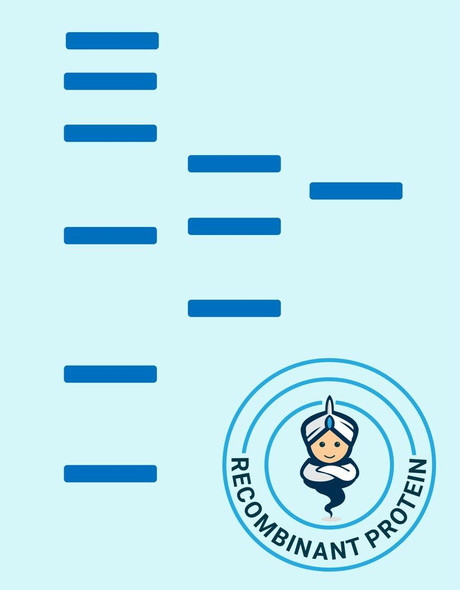Growth Factors & Cytokines Recombinant Proteins
Human Activin-A Recombinant Protein (RPPB0001)
- SKU:
- RPPB0001
- Product Type:
- Recombinant Protein
- Species:
- Human
- Uniprot:
- P08476
- Research Area:
- Growth Factors & Cytokines
Description
| Product Name: | Human Activin-A Recombinant Protein |
| Product Code: | RPPB0001 |
| Size: | 10µg |
| Species: | Human |
| Target: | Activin-A |
| Synonyms: | Inhba, Inhibin beta A, FSH releasing protein. |
| Source: | Escherichia Coli |
| Physical Appearance: | Lyophilized freeze dried powder. |
| Formulation: | Human Activin-A was lyophilized from a concentrated 1mg/ml protein solution containing 0.1% TFA. |
| Solubility: | Human INHBA protein should be reconstituted in distilled pyrogen free water to a concentration of 100ug /ml which can then be further diluted to other aqueous solutions. |
| Stability: | Lyophilized Activin-A although stable at room temperature for 3 weeks, should be stored desiccated below -18°C. Upon reconstitution Activin-A should be stored at 4°C between 2-7 days and for future use below -18°C.For long term storage it is recommended to add a carrier protein (0.1% HSA or BSA).Please prevent freeze-thaw cycles. |
| Purity: | Greater than 95% as obsereved by SDS-PAGE. |
| Amino Acid Sequence: | MGLECDGKVN ICCKKQFFVS FKDIGWNDWI IAPSGYHANY CEGECPSHIA GTSGSSLSFH STVINHYRMR GHSPFANLKS CCVPTKLRPM SMLYYDDGQN IIKKDIQNMI VEECGCS |
| Biological Activity: | Biological activity is assessed by the ability to induce cytoxicity of MPC-11 cells and was found to be 8.8ng/ml corresponding to a specific activity of 1.1 x 105 units/mg. |
Activins are homodimers or heterodimers of the different Beta subunit isoforms, part of the TGFBeta family. Mature Activin A has two 116 amino acids residues BetaA subunits (BetaA-BetaA). Activin displays an extensive variety of biological activities, including mesoderm induction, neural cell differentiation, bone remodelling, haematopoiesis, and reproductive physiology. Activins takes part in the production and regulation of hormones such as FSH, LH, GnRH and ACTH. Cells that are identified to express Activin A include fibroblasts, endothelial cells, hepatocytes, vascular smooth muscle cells, macrophages, keratinocytes, osteoclasts, bone marrow monocytes, prostatic epithelium, neurons, chondrocytes, osteoblasts, Leydig cells, Sertoli cells, and ovarian granulosa cells.
Active form Activin-A Human Recombinant produced in e.coli is a homodimeric, non-glycosylated, polypeptide chain containing 2 x 117 amino acids and having a molecular weight of 26.2kDa.The Active form Activin-A is purified by standard chromatographic techniques.
| UniProt Protein Function: | INHBA: Inhibins and activins inhibit and activate, respectively, the secretion of follitropin by the pituitary gland. Inhibins/activins are involved in regulating a number of diverse functions such as hypothalamic and pituitary hormone secretion, gonadal hormone secretion, germ cell development and maturation, erythroid differentiation, insulin secretion, nerve cell survival, embryonic axial development or bone growth, depending on their subunit composition. Inhibins appear to oppose the functions of activins. Belongs to the TGF-beta family. |
| UniProt Protein Details: | Protein type:Secreted; Secreted, signal peptide Chromosomal Location of Human Ortholog: 7p14.1 Cellular Component: extracellular region Molecular Function:cytokine activity; growth factor activity; hormone activity; identical protein binding; peptide hormone binding; protein binding; transforming growth factor beta receptor binding Biological Process: activin receptor signaling pathway; cell cycle arrest; cell development; cell differentiation; cell surface receptor linked signal transduction; cell-cell signaling; defense response; G1/S transition of mitotic cell cycle; hair follicle development; hemoglobin biosynthetic process; hemopoietic progenitor cell differentiation; male gonad development; negative regulation of B cell differentiation; negative regulation of cell cycle; negative regulation of cell growth; negative regulation of cell proliferation; negative regulation of interferon-gamma biosynthetic process; negative regulation of macrophage differentiation; negative regulation of phosphorylation; odontogenesis; ovarian follicle development; palate development; positive regulation of cellular protein metabolic process; positive regulation of erythrocyte differentiation; positive regulation of follicle-stimulating hormone secretion; positive regulation of transcription from RNA polymerase II promoter; positive regulation of transcription, DNA-dependent; progesterone secretion; regulation of follicle-stimulating hormone secretion; regulation of MAPKKK cascade; regulation of transcription from RNA polymerase II promoter; response to drug; striatal medium spiny neuron differentiation |
| NCBI Summary: | This gene encodes a member of the TGF-beta (transforming growth factor-beta) superfamily of proteins. The encoded preproprotein is proteolytically processed to generate a subunit of the dimeric activin and inhibin protein complexes. These complexes activate and inhibit, respectively, follicle stimulating hormone secretion from the pituitary gland. The encoded protein also plays a role in eye, tooth and testis development. Elevated expression of this gene may be associated with cancer cachexia in human patients. [provided by RefSeq, Aug 2016] |
| UniProt Code: | P08476 |
| NCBI GenInfo Identifier: | 124279 |
| NCBI Gene ID: | 3624 |
| NCBI Accession: | P08476.2 |
| UniProt Secondary Accession: | P08476,Q14599, |
| UniProt Related Accession: | P08476 |
| Molecular Weight: | 47,442 Da |
| NCBI Full Name: | Inhibin beta A chain |
| NCBI Synonym Full Names: | inhibin beta A subunit |
| NCBI Official Symbol: | INHBA�� |
| NCBI Official Synonym Symbols: | EDF; FRP�� |
| NCBI Protein Information: | inhibin beta A chain |
| UniProt Protein Name: | Inhibin beta A chain |
| UniProt Synonym Protein Names: | Activin beta-A chain; Erythroid differentiation protein; EDF |
| Protein Family: | Inhibin |
| UniProt Gene Name: | INHBA�� |






